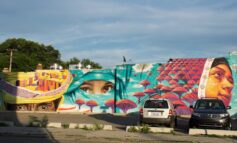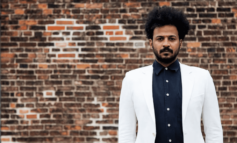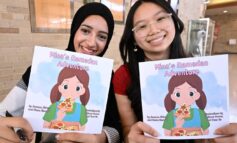HAMTRAMCK — The buildings atop the turban of the old man, found in the newly-painted Yemeni-themed mural in Hamtramck, do not seem to be weighing him down. Rather, they are flying toward a young girl, whose eyes are all that show of her face, which is covered with the sky. On the other end of the mural, a woman looks firmly into the future. Behind her are Yemeni trees ascending into an elaborate pattern.
These numerous elements evoke overwhelming thoughts and emotions: the homeland, immigration, homesickness, freedom and hope. Reactions vary from one spectator to another, and they might not be what the artist had intended. After all, art is subjective.
The mural, which covers the 80 x 16 ft wall of Sheeba restaurant in the south side of Hamtramck, was painted by renowned Chilean graffiti artist Dasic Fernández.
The freezing weather did not stop more than 20 Hamtramck residents of different backgrounds from gathering in front of the mural to celebrate its completion on Saturday, Dec. 7.
OneHamtramck, an organization that looks to promote diversity in the city, started the project, which was sponsored by the Arab American and Chaldean Council (ACC) and mostly funded by local businesses individual donors.
“Ahlan wa sahlan (welcome),” said Bill Meyer, the founder and executive director of OneHamtramck, as he greeted the crowd.
He said the mural was not funded by any government grant or major corporation.
Meyer praised Yemeni-Americans’ contributions to the city and described them as “beautiful people with a great culture.”
“Hamtramck is economically poor, but it is rich in people and history,” he said.
Hamtramck, which is almost completely bordered by Detroit, is one of the most ethnically and religiously diverse cities in the country. According to the 2010 Census, 41 percent of the city’s 22,000 residents are foreign-born. Thousands of the city’s residents are of Polish descent, and it is also home to large African American, Yemeni and Bangladeshi communities.
Meyer dedicated the mural to all the people of Hamtramck.
“Arab Americans, especially the Yemeni community, are now represented visually in this stunning piece of art,” he stated. “The mural will be here for many years to be viewed, enjoyed and studied.”
ACC program coordinator Taha Alhumdi thanked the community for “making this dream become a reality.”
“Yemenis have been spreading their culture across the world for hundreds of years,” he said. “They are loved and respected wherever they go. I am proud to be one of them.”
ACC contributed $5,000, 25 percent of the cost of the mural. Alhumdi highlighted the council’s services, which include 38 outreach centers across Metro Detroit.
“It’s a good choice to have this mural here in the heart of the Yemeni American community,” said Ali Baleed, the Yemen American Benevolent Association (YABA) executive director. “I’m glad the community will be in the history of the city. I hope they manage to keep the mural clean.”
Yasmine Hassan, who is on the mural committee, said she could identify with the Yemeni elements in the mural, “especially the use of colors.”
“It is very positive for the Yemeni youth, who take a lot of pride in the place they come from,” she added. “Now they have something they can call their own in the city. It will also help inform others about our culture.”
After the brief outdoor celebration, the crowd gathered for a discussion of the artwork with Fernández at the People’s Community Services center, across the street from Sheeba restaurant.
Fernández said he received motivating responses from the community while working on the mural for three weeks, as residents often offered him hot beverages on cold days.
The artist said he carries little parts of every community he works with.
“At the same time, I am leaving a piece of me here, so you can keep it,” he added, referring to the mural.

He said there were concerns about depicting a girl with a covered face because the veiled face could symbolize oppression. However, he added that the girl is wearing the sky, which represents freedom.
Fernández explained that he focuses on the eyes in his work because they are the “essence” of the human being. The eyes of the girl in the middle of the mural faintly display human figures. The figures are to represent the reflection of those looking at the mural, Fernández said.
He added that the woman on the right side of the mural and the trees are composed of dots, representing the bond between humans and nature. The dragon blood trees, which can only be found in Socotra, a Yemeni island, also resemble the geometric patterns in the mural to emphasize the relationship between art and nature.
People offered their own interpretation of the mural.
Palestinian American activist Hassan Nawash said the buildings flying off the turban of the old man reminded him of the uprooting of immigrants from their homeland, but the eyes young woman looking into the future on the opposite end show hope and purpose.
“This event today is a microcosm of what this mural will bring to the city,” said Nawash before reciting a poem on the artwork.





Leave a Reply